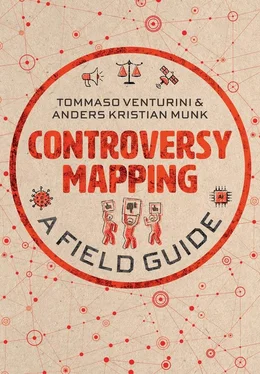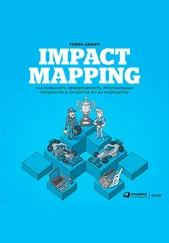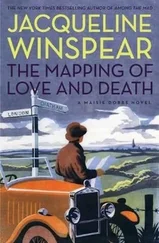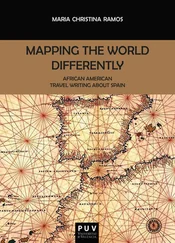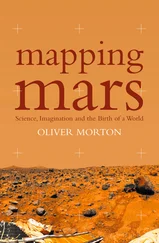Tommaso Venturini - Controversy Mapping
Здесь есть возможность читать онлайн «Tommaso Venturini - Controversy Mapping» — ознакомительный отрывок электронной книги совершенно бесплатно, а после прочтения отрывка купить полную версию. В некоторых случаях можно слушать аудио, скачать через торрент в формате fb2 и присутствует краткое содержание. Жанр: unrecognised, на английском языке. Описание произведения, (предисловие) а так же отзывы посетителей доступны на портале библиотеки ЛибКат.
- Название:Controversy Mapping
- Автор:
- Жанр:
- Год:неизвестен
- ISBN:нет данных
- Рейтинг книги:4 / 5. Голосов: 1
-
Избранное:Добавить в избранное
- Отзывы:
-
Ваша оценка:
- 80
- 1
- 2
- 3
- 4
- 5
Controversy Mapping: краткое содержание, описание и аннотация
Предлагаем к чтению аннотацию, описание, краткое содержание или предисловие (зависит от того, что написал сам автор книги «Controversy Mapping»). Если вы не нашли необходимую информацию о книге — напишите в комментариях, мы постараемся отыскать её.
Controversy Mapping A crucial field guide and hands-on companion for the digital age,
is an indispensable resource for students and scholars of media and communication, as well as activists, journalists, citizens, and decision makers.
Controversy Mapping — читать онлайн ознакомительный отрывок
Ниже представлен текст книги, разбитый по страницам. Система сохранения места последней прочитанной страницы, позволяет с удобством читать онлайн бесплатно книгу «Controversy Mapping», без необходимости каждый раз заново искать на чём Вы остановились. Поставьте закладку, и сможете в любой момент перейти на страницу, на которой закончили чтение.
Интервал:
Закладка:
Some people have not found their way into the above narrative despite contributing ideas, providing feedback and in general being part of an ongoing conversation about controversy mapping: Kari De Pryck, David Moats, Nicolas Baya-Laffite, Francesca Musiani, Timothée Collignon, Ian Gray, Niranjan Sivakumar, Trevor Pinch, Thomas Turnbull, Vincent Lépinay, Oscar Coromina, Oscar Maldonado, Liam Heaphy, Massimiano Bucchi, Federico Neresini, Andrea Lorenzet, David Chavalarias, Eric Fleury, Marc Barbier, Astrid Oberborbeck Andersen, Tobias Bornakke, Jean-Paul Vanderlinden, Vivian Depoues, Didier Bigo, François Gemenne, and, not least, all our amazing students.
A special thanks goes to Marcella, Gilberto, Birgitte, and Ebbe, who taught us to be curious about complex things. And an even more special thanks to those who have been forced to witness the slow birth of the book up close, dealing with fallouts and frustrations, and doing their best to share our enthusiasm for a project that at times seemed never-ending: Kari, Mateo, Anne-Kirstine, and Gustav, who have patiently observed the entire writing process from the sideline, and Bertha, who was born into it. The manuscript was revised on a permanently open conference call while we were all working from home during the long months of COVID-induced lockdown in 2020. Only your indulgence made that possible.
We would also like to thank our editors at Polity Press, Stephanie Homer, Ellen MacDonald-Kramer, and Mary Savigar, as well as the anonymous reviewers for taking this on, seeing it through, and making it so much better along the way. Thanks to Ian Tuttle, who revised the proofs of the book and corrected many of our mistakes. We are grateful to Giulia Marelli (Arnalda Gourmet), Gruppo Food, Craig Robinson, Nikolaos Askitas, Klaus Zimmermann, Vincent Traag, Thomas Franssen, Duncan Watts, Steven Strogatz, Albert-Laszlo Barabási, Michel Callon, URBAN POWER, Lendager Group, John M. Eriksen, Ole Malling, Camilla Hiul Suppli, Niels Dalum Hansen, Mette Rasmussen, Palle Valentiner-Branth, Tyra Grove Krause, and Kåre Mølbak for giving us the permission to reproduce the images in this field guide.
And we would like to thank the institutions who have financially supported our work with the book: the Carlsberg Foundation, the Department of Learning & Culture at the University of Aalborg, Sciences Po Paris, the Digital Humanities Department of King’s College London, INRIA, and the CNRS.
Finally, there is one person whose contribution warrants its own section, namely Michael Flower, who has meticulously read and reread many consecutive versions of the manuscript, and provided not only constructive commentary and critique but incessant and unyielding support. Thanks, Michael: your encouragement has meant a lot to us.
Preface: The politics of association on display
Richard Rogers
As this book aptly demonstrates, there is a certain fit between Actor-Network Theory (ANT), controversy mapping, and digital methods. From the outset, digital methods were informed by ANT and sought to operationalize controversy mapping, for the purpose of investigating imbroglios such as the ones described in the book. They did so in at least three ways: putting actor association on display through link mapping, furnishing a coarse view of actor partisanship through mention mapping, and inserting the maps into the issue space, as they are part of it rather than only representations.
As Venturini and Munk discuss, associations are the main focus of ANT and the prime way in which controversies are fought and societal arrangements established. In order to put actor association on display, colleagues and I would capture how websites link to one another. Long before the industrialization, automation, and eventual decline of the hyperlink (in favor of the “like,” the “follower,” and very differently the “hashtag”), each link was hand-made by a webmaster, with particular proclivities or even policies. Linking was thus noncapricious and selective. Hyperlinking practices thus reminded us of the way in which scientists use references to mark their positioning in the academic field, but we extended these associational practices to a much larger and more diverse number of actors.
Once mapped, these links could be telling. One could profile and also typify the players in a public dispute beyond their usual roles, as outlined in the chapter about controversy actors. They could be profiled through the manner in which they linked and were linked to. Who does the actor link to? Why does the actor receive those particular inlinks? Which links could be regarded as conspicuously missing?
We found certain types and styles of association. There were aspirational links, with actors desiring association with another actor, often without reciprocation. There was cordial linking, where actors link to their affiliates and colleagues in the same space. There was critical linking, with actors pointing to culprits or addressees of an issue or problem. There were other types and styles, too, such as non-linking, self-linking, kinship linking, transdiscursive linking, and so forth.
Like Google, we also discovered that the sum of one’s inlinks is worth investigating, for it could be deployed as a reputational marker. But it also could deliver signs of where an actor’s sympathies lie. We wanted to enable the study of the politics of association, which, as argued over and again in this field guide, is a key task in controversy mapping.
Links may show alignments. They may reveal the company an actor keeps, or unlikely bedfellows. Particularly when displayed through the techniques described in the sections on visual network analysis, the investigation of links could indicate actor standing. There are hierarchies in networks, and links furnish certain actors with prominence and centrality. “Orphan” websites, without inlinks, did not make it onto the maps, however, so non-association would require another technique (such as mentions mapping, discussed below).
More broadly, these webs of actor links, in other words, were considered networks. Linking actively brings networks into being. They create a space of interaction and circulation, the “magmatic” space of alliances and oppositions described in the book. They each may be characterized by the material they circulate and the activity they display. Rather than structural, such as “old boy networks,” we found them to be dynamic, and continually in need of glue. These networks, we thought, were held together by what they principally circulate. Debate networks circulate positions, scandal networks accusations, issue networks urgency, summit networks announcements, and protest networks mobilization.
The rates at which these networks circulate the material, through the updating of their websites, could be considered a measure of dedication or care. The “health” or hardiness of the issue, protest, and so forth could be monitored. In order to do so, the maps went live.
We would build issue tickers and other displays to show an issue’s current state. In one example, we monitored NGO campaigning behavior, and when NGOs would leave an issue, in the sense of ceasing its advocacy, the issue’s state would decline. One could similarly monitor a controversy, and when it is the hottest, or in full motion, that is the occasion to map and chart it.
Second, we mapped mentions. In order to capture an actor’s partisanship or issue commitment, we learn from how actors mention each other as well as each other’s issue language. It is an issue mapping exercise, where, for example, we asked, which actors in the climate change space mention the skeptics? Here the idea is to gain a rough indication of skeptic-friendly sources. (Sources skeptical of the skeptics also appear, so close reading and annotation are essential.)
Читать дальшеИнтервал:
Закладка:
Похожие книги на «Controversy Mapping»
Представляем Вашему вниманию похожие книги на «Controversy Mapping» списком для выбора. Мы отобрали схожую по названию и смыслу литературу в надежде предоставить читателям больше вариантов отыскать новые, интересные, ещё непрочитанные произведения.
Обсуждение, отзывы о книге «Controversy Mapping» и просто собственные мнения читателей. Оставьте ваши комментарии, напишите, что Вы думаете о произведении, его смысле или главных героях. Укажите что конкретно понравилось, а что нет, и почему Вы так считаете.
